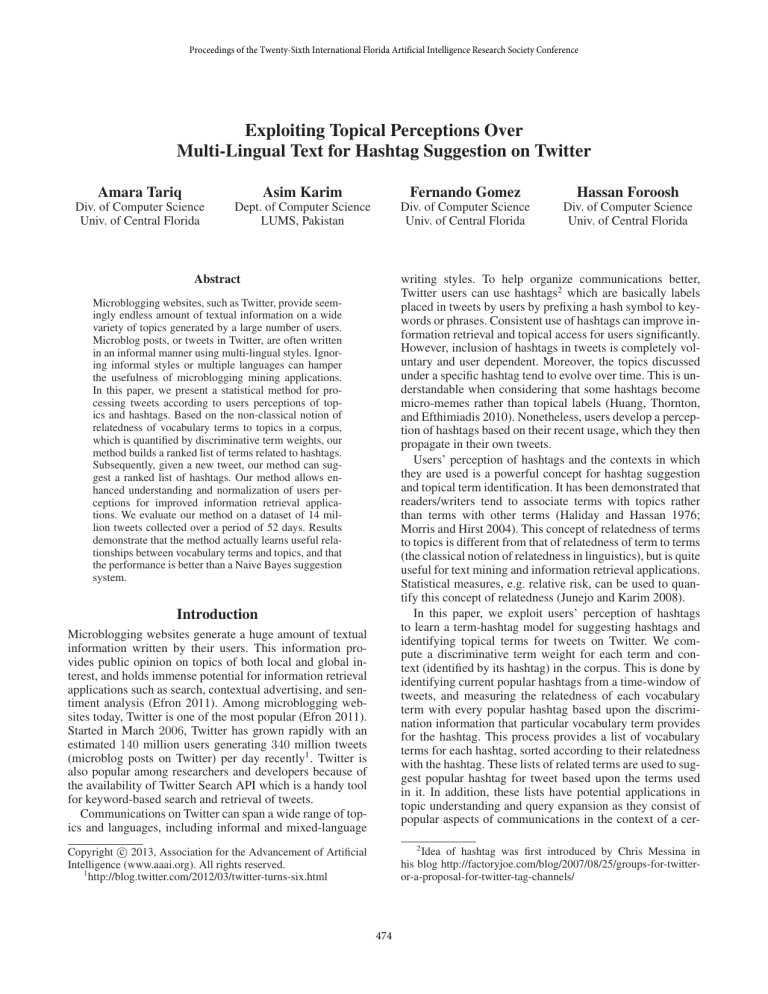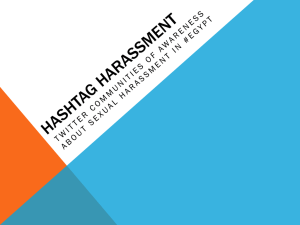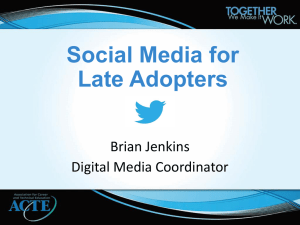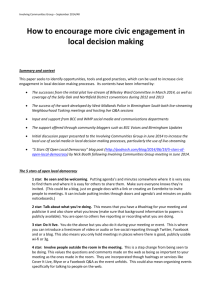
Proceedings of the Twenty-Sixth International Florida Artificial Intelligence Research Society Conference
Exploiting Topical Perceptions Over
Multi-Lingual Text for Hashtag Suggestion on Twitter
Amara Tariq
Asim Karim
Fernando Gomez
Hassan Foroosh
Div. of Computer Science
Univ. of Central Florida
Dept. of Computer Science
LUMS, Pakistan
Div. of Computer Science
Univ. of Central Florida
Div. of Computer Science
Univ. of Central Florida
Abstract
writing styles. To help organize communications better,
Twitter users can use hashtags2 which are basically labels
placed in tweets by users by prefixing a hash symbol to keywords or phrases. Consistent use of hashtags can improve information retrieval and topical access for users significantly.
However, inclusion of hashtags in tweets is completely voluntary and user dependent. Moreover, the topics discussed
under a specific hashtag tend to evolve over time. This is understandable when considering that some hashtags become
micro-memes rather than topical labels (Huang, Thornton,
and Efthimiadis 2010). Nonetheless, users develop a perception of hashtags based on their recent usage, which they then
propagate in their own tweets.
Users’ perception of hashtags and the contexts in which
they are used is a powerful concept for hashtag suggestion
and topical term identification. It has been demonstrated that
readers/writers tend to associate terms with topics rather
than terms with other terms (Haliday and Hassan 1976;
Morris and Hirst 2004). This concept of relatedness of terms
to topics is different from that of relatedness of term to terms
(the classical notion of relatedness in linguistics), but is quite
useful for text mining and information retrieval applications.
Statistical measures, e.g. relative risk, can be used to quantify this concept of relatedness (Junejo and Karim 2008).
In this paper, we exploit users’ perception of hashtags
to learn a term-hashtag model for suggesting hashtags and
identifying topical terms for tweets on Twitter. We compute a discriminative term weight for each term and context (identified by its hashtag) in the corpus. This is done by
identifying current popular hashtags from a time-window of
tweets, and measuring the relatedness of each vocabulary
term with every popular hashtag based upon the discrimination information that particular vocabulary term provides
for the hashtag. This process provides a list of vocabulary
terms for each hashtag, sorted according to their relatedness
with the hashtag. These lists of related terms are used to suggest popular hashtag for tweet based upon the terms used
in it. In addition, these lists have potential applications in
topic understanding and query expansion as they consist of
popular aspects of communications in the context of a cer-
Microblogging websites, such as Twitter, provide seemingly endless amount of textual information on a wide
variety of topics generated by a large number of users.
Microblog posts, or tweets in Twitter, are often written
in an informal manner using multi-lingual styles. Ignoring informal styles or multiple languages can hamper
the usefulness of microblogging mining applications.
In this paper, we present a statistical method for processing tweets according to users perceptions of topics and hashtags. Based on the non-classical notion of
relatedness of vocabulary terms to topics in a corpus,
which is quantified by discriminative term weights, our
method builds a ranked list of terms related to hashtags.
Subsequently, given a new tweet, our method can suggest a ranked list of hashtags. Our method allows enhanced understanding and normalization of users perceptions for improved information retrieval applications. We evaluate our method on a dataset of 14 million tweets collected over a period of 52 days. Results
demonstrate that the method actually learns useful relationships between vocabulary terms and topics, and that
the performance is better than a Naive Bayes suggestion
system.
Introduction
Microblogging websites generate a huge amount of textual
information written by their users. This information provides public opinion on topics of both local and global interest, and holds immense potential for information retrieval
applications such as search, contextual advertising, and sentiment analysis (Efron 2011). Among microblogging websites today, Twitter is one of the most popular (Efron 2011).
Started in March 2006, Twitter has grown rapidly with an
estimated 140 million users generating 340 million tweets
(microblog posts on Twitter) per day recently1 . Twitter is
also popular among researchers and developers because of
the availability of Twitter Search API which is a handy tool
for keyword-based search and retrieval of tweets.
Communications on Twitter can span a wide range of topics and languages, including informal and mixed-language
2
Copyright c 2013, Association for the Advancement of Artificial
Intelligence (www.aaai.org). All rights reserved.
1
http://blog.twitter.com/2012/03/twitter-turns-six.html
Idea of hashtag was first introduced by Chris Messina in
his blog http://factoryjoe.com/blog/2007/08/25/groups-for-twitteror-a-proposal-for-twitter-tag-channels/
474
tain topic or hashtag. We evaluate our method on 14 million
tweets in four time-window segments. The results show a
significant improvement in hashtag suggestion over a baseline method. We also highlight and discuss the temporal and
language characteristics of hashtag usage on Twitter.
measure of performance of the system without using explicit
human-judgment on results.
Two-way Information Retrieval from Microblog
Posts
The lists of terms identified as related to a topic (see table
4) can provide two-way utility for information retrieval systems. Users may put no hashtag or use less-popular hashtags
in their tweet. For example, most popular hashtag used in the
context of playstation 3 was ‘PS3’. Some other users used
less-popular hashtag of ‘playstation3’ in the same context.
On one hand, our system can improve consistency in the use
of hashtags, in turn improving performance of IR algorithms
making use these tags, by suggesting suitable hashtags for
tweets.
On the other hand, microblog posts or simply microblogs
corpora for opinion mining are generally collected through
query-matching or keyword search from microblogging
websites. The terms identified as related to a topic by our
system, hints towards multiple aspects of discussion under
the same topic. For example, the terms related to ‘Pakistan’
in table 5 hints towards flood situation (‘flood’ , ‘floodrelief’
, ‘CWF’), sports personalities (‘Aisam’) and political parties
(‘MQM’) discussed in the context of Pakistan. Using this
list of related terms as keywords for search will help cover
various aspects of the single topic in the retrieved corpus.
Related Work
Twitter users can generate a variety of meta-data e.g. hashtag, mention (@screen name), retweet (RT) (Efron 2011).
Hashtags provide topical access to tweets and their importance and usefulness have been widely explored in the context of query expansion (Massoudi et al. 2011; Lau, Li, and
Tjondronegoro 2011). Better and consistent use of hashtags by Twitter users will improve topical access to tweets
and performance of any system making use of hashtags. In
this paper, we have presented a hashtag suggestion system
which can help Twitter users select suitable hashtags for
their tweets based on vocabulary terms used in their tweets.
Such suggestion systems have not been widely explored in
the context of microblog posts. A. Mazzia et al. have provided a preliminary suggestion system, using a Naive Bayes
approach, with much focus on pre-processing steps (Mazzia
and Juett ). We have quantified topic-term relationships similar to human perception of text, used much larger corpus,
included text from multiple languages and explored temporal behavior of both hashtags and their relevant terms. The
system develops lists of terms related to each popular topic
of discussion.
Topics of discussion tend to evolve rapidly over time on microblogging websites. We have trained the system over short
windows of time to account for this evolution. We have developed an evaluation system without using human judgment by considering hashtag as label/topic for tweet as hashtags are supposed to provide topical access to tweets. This
idea is similar to the sentiment analysis system for Twitter
presented by Go et. al., which uses emoticons as judgment
on sentiment of tweet (Go, Bhayani, and Huang 2009).
Statistical Techniques for Informal and
Multi-lingual datasets
The relationship between vocabulary terms can be either
based on classical lexical rules of synonymy, antonymy, hypernymy etc. (Resnik 1999) or statistical information (Haliday and Hassan 1976). Statistical measure of relatedness
between terms and topics can be evaluated based upon the
frequency of co-occurrence of the terms and the frequency
of occurrence of the terms in the context of a given topic.
Identification of lexical relationships in microblogs corpus is
hard because microblogs may contain informal language or
may even be written in multiple languages. Statistical techniques can readily establish topic-term relationships on such
dataset. Therefore, we have focused mainly on statistical relationships between terms and topics.
Motivation
In this section, we discuss the motivation for hashtag suggestion and our proposed methodology.
Dependence on Perception of Users
Statistical Measure of Relatedness
In this paper, we have used hashtags present in tweets as label/topics. Humans tend to group together vocabulary terms
in the context of a topic, rather than associating terms with
other terms (Haliday and Hassan 1976). Our system makes
use of the same idea. It quantifies relatedness of terms to topics/labels to identify topic-terms relationships. Since we use
hashtags provided by users as labels/topics, these topic-term
relationships are actually users’ perceptions of relationships
between vocabulary terms and hashtags. Our system creates
lists of terms related to each hashtag e.g. ‘travel’ (see table
4). Terms listed as related to ‘travel’ may not have any lexical relationship such as antonymy, synonymy or hypernymy
with ‘travel’. But they are related to ‘travel’ in the perception of users. Moreover, we have used a similarly labeled
dataset for evaluation purposes, thus providing a quantitative
In this section, we shall establish quantitative measures such
as discriminative term-weight (DTW) and relatedness score
to quantify topic-term relationships.
Discriminative Term Weight
Discriminative term weights (DTW) are typically used to
quantify the evidence or hint a term provides for a certain context or topic (Tariq and Karim 2011; Junejo and
Karim 2008). Measures of discrimination information have
been studied extensively for classification, association rulemining and feature selection in literature. A detailed evaluation of three of such discrimination measures (i.e. KL divergence, relative risk, log-relative risk) has been described
in (Junejo and Karim 2008). According to (Tariq and Karim
475
DTW-based Hashtag Suggestion System
2011), the discriminative term weight of term tj for category
Tk is defined as
p(tj |Tk )
dtw(tj , Tk ) =
(1)
p(tj |T̄k )
Algorithm 1 DTW-based hashtag suggestion system
a
1: Input: {ds }N
s=1 (Tweets generated during time period
where p(tj |Tk ) denotes the probability of term tj in documents belonging to category Tk and T̄k refers to documents in all categories but Tk . If dtw(tj , Tk ) > 1 then term
tj provides positive discrimination information for category
Tk , with larger values representing stronger discriminative
power. A labeled set of documents is required to estimate
these probability values. In our case, each microblog is one
document with the category/label Tk provided by hashtag
of the microblog. Vector xi of size M , where M is the
size of vocabulary set, represents ith document/microblog.
If the term weight in each microblog is a binary value (i.e.
xij ∈ 0, 1 for all i and j) following the Bernoulli distribution, then the maximum likelihood estimate of p(tj |Tk ) is
given by
PNk
xij
p̄(tj |Tk ) = i=1
(2)
Nk
where Nk is the number of microblogs belonging to hashtag Tk . Division by zero is avoided by add-one smoothing.
Notice that the estimation of these probabilities requires K
passes over the microblog collection, where K is the total
number of popular hashtags under consideration. With all of
the discriminative term weights, the set of terms Vk providing significant positive discrimination information for hashtag Tk is defined as
Vk = {tj kdtw(tj , Tk ) > λ ∀j}
2:
3:
4:
5:
6:
7:
8:
9:
10:
11:
12:
13:
14:
15:
16:
(3)
where λ ≥ 1 is a term selection threshold controlling the
exclusion of insignificant terms. In general, Vk ∩ Vl 6= ∅
for all k and l. It means that vocabulary terms can provide
significant positive discrimination information for more than
one hashtags. Also, depending on the value of λ, ∪k Vk =
6 V
as some terms may not provide significant discrimination
information for any hashtag (Tariq and Karim 2011).
17:
18:
19:
20:
21:
22:
23:
24:
25:
26:
27:
Relatedness of Terms to Topic/Context
The measure of relatedness between a term and a topic is the
product of the weight of the term in the topic and the discrimination information provided by the term for the topic
(Cai and van Rijsbergen 2009). We have already described
the measure of discrimination information that a term provides for a hashtag in the previous section. Conditional probability of term tj in a given hashtag/topic Tk is the weight of
the term in the topic Tk . The higher this weight, stronger the
hint term tj provides for Tk . Thus, the relatedness measure
can be described as the product of dtw(tj , Tk ) and p(tj |Tk )
(Tariq and Karim 2011).
rel(tj , Tk ) = p(tj |Tk ) × dtw(tj , Tk )
b
[t1,t2]), {df }N
f =1 (Tweets generated during time period
[t2,t3]), θt (threshold of frequency for selection of vocabulary term), θK (threshold of frequency for selection
of hashtag), θS (threshold of similarity score for suggestion of hashtag)
Output: {yk }K
k=1 (Vectors for each popular hashtag),
Nb
{Tf }f =1 (lists of suggested hashtags for all df )
// Training of model
Na
Extract all hashtags {Tl }L
l=1 from {ds }s=1
Count number of occurrences T cl of each Tl
TK ← {Tk }K
k=1 (set of popular hashtags) consisting of
each Tl with T cl > θK , K < L
Set of tweets {di }N
i=1 , consisting of every ds which have
at least one hashtag from set TK , N < Na
tokenize every di to get corresponding size M binary
vector representation xi and ordered set of vocabulary
terms V ← {tj }M
j=1 , frequency of tj is at least θt
// dtw(tj , Tk ) and rel(tj , Tk )
for k = 1 → K do
for j = 1 → M do
dtw(tj , Tk ) ← discriminative term weight of term
tj for hashtag Tk (Eq. 1)
rel(tj , Tk ) ← relatedness of term tj to hashtag Tk
(Eq. 4)
end for
Vk ← significant terms for hashtag Tk (Eq. 3)
yk ← vector of size M corresponding to Tk ,
rel(tj , Tk ) on all indices corresponding to tj in Vk
, zero on all other indices
end for
//Hashtag suggestion
tokenize all df and get corresponding binary termweight vector xf over vocabulary set V
// for each df
for k = 1 → K do
Sk ← xf · yk
if Sk < θS then
Sk ← 0
end if
end for
list Tf for tweet df , consisting of all Tk corresponding
to non-zero Sk , sorted in decreasing order of Sk
The relatedness between terms and context, described by
equation 4, has been employed in dimensionality reduction
algorithm for textual data, named as feature extraction based
on discrimination information pooling (FEDIP) (Tariq and
Karim 2011). We have used the relatedness score, calculated based on discriminative term weights (DTW), to identify topic-term relationships between vocabulary terms used
in microblog posts and their topics. Our system uses these
relationships to suggest hashtags for microblog posts.
Overall structure of the DTW-based hashtag suggestion
(4)
The feature extraction based upon this relatedness measure
provides a readily interpretable form of features in the textual data (Tariq and Karim 2011). Most of the traditional
feature extraction methods e.g. principal component analysis, linear discriminant analysis, and latent semantic indexing lack this quality.
476
Table 1: Statistics of Training and Test datasets
system has been presented in algorithm 1. Training algorithm generates a vector corresponding to each popular
hashtag. System outputs a list of suitable hashtags for a tweet
in testing data, ranked on the basis of cosine similarity score
between tweet and hashtag vectors. In reality, these hashtags may be vocabulary terms already used in tweet, prompting user to put hash sign before those terms or they may be
term not included in tweet, prompting user to put these terms
along with hash sign in tweet. If all hashtags get similarity
scores weaker than threshold θS , it indicates that tweet does
not mention any popular topic.
Tweet are treated as a Unicode encoded strings. Tokenization is based upon occurrence of any non-alphanumeric
character. This method is blind to the language(s) used in
a tweet and provides crude tokenization. Only the term providing significant positive discriminative information for a
hashtags have non-zero value in trained model (line 16 of
algorithm 1). This step effectively filters out a lot of gibberish terms produced because of naive tokenization system.
Moreover, tweets in test set are stripped of hashtag information at this step before they are fed to system for suggestion
of suitable hashtags.
Part of
Dataset
Part1
Part2
Part3
Part4
No. of popular
hashtags
3621
1729
843
293
133
3836
1887
903
318
143
4193
2093
1015
354
166
4045
2007
945
330
150
No. of tweets in
Training set
313937
275238
236046
180514
146247
343351
305055
264169
207388
169834
372822
332053
288375
228372
186882
353366
313163
270593
212167
170691
No. of tweets in
Test set
117550
102950
89439
69197
56958
142383
127326
110932
87363
72047
143981
128383
111529
88790
71653
122305
109145
95002
74513
61110
Bayes scores. The performance of this system is comparable
to the DTW-based system and much better than baseline system. These results indicate that discriminative term weight
is an effective indicator of topic-term relationship. Since our
proposed hashtags suggestion system relies on correct identification of these relationships, it benefits greatly if discriminative term weights are incorporated in the overall system.
The performance of our system improves non-linearly as θK
is increased, resulting in reduced size of set TK . As θK
is increased, model is trained better because of increased
number of tweets for each hashtag. Moreover, the system
has to chose from a smaller pool of possible hashtags as K
decreases. We have conducted another set of experiments
where the system suggests all hashtags for a certain tweet
whose relatedness scores are greater than the chosen threshold, to observe effects of hashtag selection threshold (i.e.
θS in algorithm 1). As this threshold increases, fewer but
higher scoring hashtags are used as annotations resulting in
increase in precision but decrease in recall. Figure 2 provides
curves depicting change in overall precision and recall of the
DTW-based and baseline systems, generated by varying this
threshold θS , for each value of θK in all four parts of dataset.
The DTW-based system’s performance is far superior to that
of baseline system.
Table 3 provides best hashtags suggested for a few tweets
written without hashtags. Inclusion of such tweets in the test
set will require human judgment for evaluation.
Data-set and Empirical Evaluation
We have evaluated our system over an extensive dataset of
14 million tweets collected over a period of 52 days during September and October of 2010. About 14.5% of all
tweets have hashtags. The dataset has been divided into 4
parts, based on time of entry of tweet, to account for temporal evolution of topics over microblog-space. For each part,
the system is trained over tweets generated in 12 consecutive days and evaluated over tweets containing at least one
popular hashtag, generated in next 6 days. The set of popular
hashtags (i.e. TK ) for each part includes hashtags occurring
with more than a certain frequency (θK ) in that time period.
We have experimented with different values of θK , resulting in five different sizes of TK and the training and test
datasets for each of four temporally divided portions of data.
Table 1 provides the statistics for each part of the dataset for
different TK used for evaluation. For evaluation purposes,
the system suggests as many top-ranked hashtags as there
are actual hashtags attached with tweet by user. Table 2 provides mean precision, mean recall, mean F-score per hashtag
and number of hashtags with non-zero recall. These performance measures are popular for automatic image annotation
systems. Since our system provides keyword annotations for
tweets, we have used similar evaluation criterion.
Similar pre-processing steps, the training and test datasets,
the set of popular hashtags and the evaluation criterion have
been used for all systems. We have generated baseline results using a simple Naive Bayes scoring system in which
suitable hashtags for each tweet are selected on the basis
of their Naive Bayes score in context to that tweet. The
DTW-based system performs much better than this baseline
system. We have also proposed a variation of the DTWbased system, named as FEDIP-Naive Bayes. In FEDIPNaive bayes, dimensionality of tweets dataset is reduced using FEDIP (Tariq and Karim 2011) and then suitable hashtags for each tweet are suggested on the basis of their Naive
Discussion
Popular topics of discussion over microblog-space tends to
evolve over time, with different topics evolving with different patterns. Since hashtags are meant to provide topical access to microblog posts, evolution patterns of topics are reflected in the evolution of corresponding hashtags. Figure
1 depicts evolution patterns for 4 different hashtags. Some
hashtags e.g. ‘VMA’ are only popular for a short period of
477
Table 2: Performance comparison between three different systems
Part of
Dataset
Part1
Part2
Part3
Part4
Mean
Precision
61.07
67.62
72.93
79.46
82.72
59.84
65.95
70.71
77.41
84.23
59.07
64.21
70.06
77.16
80.01
59.18
64.91
70.40
76.82
81.12
DTW-based system
Mean
Mean
No. of hashtags
Recall F-score
with recall>0
80.70
64.42
3216
84.39
71.18
1605
86.43
75.84
800
87.72
80.73
282
87.62
82.27
129
80.42
63.27
3416
83.57
69.18
1767
86.29
74.06
870
87.95
79.36
309
90.17
84.19
141
79.84
62.45
3743
82.11
67.55
1940
85.77
73.44
970
87.62
79.19
342
87.81
80.63
161
79.47
62.53
3579
83.57
68.42
1880
86.05
73.90
909
88.39
79.47
320
88.31
81.73
146
Mean
Precision
37.67
54.50
68.05
75.41
75.45
31.57
45.72
62.44
75.18
78.61
31.23
45.49
59.41
72.90
75.32
30.01
44.29
61.61
73.84
76.56
Naive Bayes (baseline)
Mean
Mean
No. of hashtags
Recall F-score
with recall>0
18.74
20.80
1486
27.42
30.00
1054
36.43
39.28
657
49.83
52.15
260
61.92
63.37
121
14.03
15.80
1300
20.14
22.50
955
27.87
30.84
634
41.77
44.63
275
55.87
58.78
131
13.32
15.24
1405
18.95
21.54
1053
25.97
28.87
684
38.79
41.72
303
51.52
53.69
149
14.42
15.97
1314
20.48
23.04
991
29.33
32.54
659
42.59
45.64
287
55.61
58.17
139
Mean
Precision
62.15
68.75
73.73
79.78
84.09
60.40
66.70
72.32
78.35
85.20
59.99
64.20
70.26
78.18
80.81
59.84
65.60
71.65
78.82
82.81
FEDIP-Naive Bayes
Mean
Mean
No. of hashtags
Recall F-score
with recall>0
71.68
63.43
3131
76.12
69.50
1589
78.90
74.13
797
83.22
79.90
282
87.18
84.37
129
69.83
61.83
3308
74.68
67.73
1745
78.73
72.93
862
82.73
78.25
308
88.54
85.03
141
68.87
61.00
3635
71.58
64.84
1911
77.16
71.25
962
82.70
78.65
340
85.09
80.98
160
69.00
61.00
3447
73.64
66.49
1834
78.03
72.47
897
83.12
78.81
319
86.23
82.79
144
Figure 1: Number of tweets per day containing four different hashtags; each bar represents one day
Figure 2: Precision-recall curves for baseline (NB) system and DTW-based system (DTW). Style of curve indicates specific
size of training and test sets; color indicates system.
Table 3: Sample hashtags suggested for tweets with no popular hashtag
news
freelance
travel
40 Days for Life launching London campaign :: Catholic News Agency
(CNA): http://bit.ly/aINNQt via @addthis
1000s of freelance jobs available, from programming to writing!
Earn cash while building your portfolio! http://tinyurl.com/37pvcfh
American Airlines Labor Day Sale from $136 Round
Trip (travel September 4,5,8) http://weurge.com/vacations. Denver to Los Angeles $136
478
time while other hashtags e.g.‘travel’ remain popular for an
extended period. Table 4 provide lists of terms strongly related to a few topics. These lists evolve over time to keep
up with evolution pattern within a topic. Table 5 provides
lists of strongly related terms to hashtag ‘Pakistan’ over two
windows of time. Our system has identified popular aspects
of discussion in the context of ‘Pakistan’ which can be verified against the time-line of actual events e.g. ‘Aisam’ appears only in one window, corresponding to the time when
Pakistani player named ‘Aisam’ won US open doubles semifinal.
hashtags to users. Consistent use of hashtags will improve
performance of all IR systems for Twitter which depend
upon topical access provided by hashtags. The topic-term
relationships learned through this system evolve over time.
Thus, this system implicitly provides a temporally evolving
summary or a pool of topics for opinion mining. In future, a
hybrid system making use of both statistical and rule-based
relationships between topic and terms can be developed.
References
Cai, D., and van Rijsbergen, C. J. 2009. Learning semantic
relatedness from term discrimination information. Expert
Systems with Applications 36:1860–1875.
Efron, M. 2011. Information search and retrieval in microblogs. In Journal of the American Society for Information
Science and Technology (JASIST), volume 62, 996–1008.
Go, A.; Bhayani, R.; and Huang, L.
2009.
Twitter sentiment classification using distant supervision.
http://www.stanford.edu/∼alecmgo/papers/
TwitterDistantSupervision09.pdf.
Haliday, M. A. K., and Hassan, R. 1976. Cohesion in English. London, UK: Longman.
Huang, J.; Thornton, K. M.; and Efthimiadis, E. N. 2010.
Conversational tagging in twitter. In Proceedings of the
21st ACM conference on Hypertext and hypermedia, HT ’10,
173–178. New York, NY, USA: ACM.
Junejo, K., and Karim, A. 2008. A robust discriminative
term weighting based linear discriminant method for text
classification. In Data Mining, 2008. ICDM ’08. Eighth
IEEE International Conference on, 323 –332.
Lau, C. H.; Li, Y.; and Tjondronegoro, D. 2011. Microblog
retrieval using topical features and query expansionl. In Text
REtrieval Conference.
Massoudi, K.; Tsagkias, M.; de Rijke, M.; and Weerkamp,
W. 2011. Incorporating query expansion and quality indicators in searching microblog posts. In Proceedings of the 33rd
European Conference on Advances in Information Retrieval,
ECIR’11, 362–367. Berlin, Heidelberg: Springer-Verlag.
Mazzia, A., and Juett, J. Suggesting hashtags on twitter. http://www-personal.umich.edu/∼amazzia/pubs/545final.pdf.
Morris, J., and Hirst, G. 2004. Non-classical lexical semantic relations. In Proceedings of the HLT-NAACL Workshop on Computational Lexical Semantics, CLS ’04, 46–51.
Stroudsburg, PA, USA: Association for Computational Linguistics.
Resnik, P. 1999. Semantic similarity in a taxonomy: An
information-based measure and its application to problems
of ambiguity in natural language. Journal Of Artificial Intelligence Research 11:95–130.
Tariq, A., and Karim, A. 2011. Fast supervised feature extraction by term discrimination information pooling. In Proceedings of the 20th ACM International Conference on Information and Knowledge Management, CIKM ’11, 2233–
2236. New York, NY, USA: ACM.
Table 4: Sample of lists of vocabulary terms related to topics
tech
travel
sports
health
‘tech’, ‘gadgets’, ‘intmkt’, ‘nolabel’, ‘ED’ ,‘mobile’
‘Gree’, ‘cell’, ‘OpenLierox’,‘LCDs’
‘travel’, ‘Augustine’, ‘vacations’, ‘tourism’, ‘lp’
‘traveldudes’, ‘florida’, ‘tours’, ‘pr’,‘VisaGuru’
‘sports’, ‘martialarts’, ‘college’, ‘baseball’, ‘sportsnews’
‘superbowl’, ‘Betting’, ‘hockey’, ‘nba’,‘tennis’
‘health’, ‘wellness’, ‘diet’, ‘HealthHabits’, ‘weightloss’
‘fitness’, ‘obesity’, ‘nutrition’, ‘yoga’,‘allergies’
Table 5: Sample of terms related to hashtag ‘Pakistan’ from
two different parts of dataset
Pakistan; Part1 (04 to 15 September,2010)
‘floods’, ‘Pakistan’, ‘floodrelief’, ‘HelpPakistan, ‘Aisam’
‘victims’, ‘relief’, ‘CWF’, ‘savethechildren’, ‘PKrelief’
Pakistan; Part2 (16 to 25 September,2010)
‘Pakistan’, ‘PKfloods’, ‘CWF’, ‘karachi’, ‘HelpPakistan’
‘StateDept’ , ‘Aafia’, ‘MQM’, ‘WFP’, ‘Holbrooke’
Many tweets have an iso-language code, assigned to the
user who created the tweet. Users who are assigned one
language code, may write tweets in other languages. Still,
iso-language code provides a rough estimate for different
languages being used for a particular hashtag. We have observed 27 different iso-language codes in our dataset. Both
English(‘en’) and Persian(‘fa’) are dominant languages in
the context of hashtag ‘iranElection’. Some hashtags describing generalized topics e.g. ‘sports’ also tend to have
multiple dominant languages. Table 6 provides a few hashtags with multiple or non-English dominant languages.
Table 6: Language related observations for hashtags
Hashtags with multiple dominant languages
‘sport’ , ‘freelance’ , ‘profile’ , ‘iranElection’
Hashtags with non-English dominant language
‘Cuba(es)’,‘sorteio (pt)’,‘kaskus(id)’ ,‘novosti(ru)’
Conclusion
Textual data posted by users on online social networks has
huge potential for information retrieval (IR) application because of its very high growth rate and coverage of vast
variety of topics. We have focused on a large dataset collected from Twitter and used discriminative-term-weights to
establish topic-term relationships, without using dictionary
or grammar of any language. This system learns users’ perception of topic-term relationships and then suggest suitable
479







